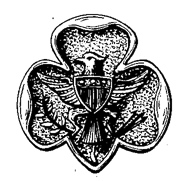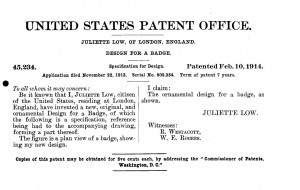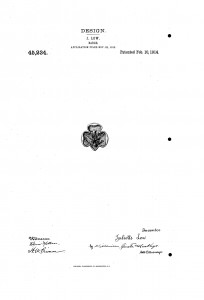Not long after Juliette Gordon Low brought the Girl Scouts to the United States, she created this badge:
It was based on the trefoil used by Sir Robert Baden-Powell’s Boy Scouts, and because of that, it clearly linked her Girl Scouts to the larger Scouting family.
On 22 November 1913, she applied for a patent, and it was granted to her on 10 February 1914. Here is her application:
And all was well until 1921.
By that year, the Girl Scouts had grown so tremendously since their founding in 1912 that Juliette Low had seen fit to step down as President. (There’s a whole fascinating story there, by the way.) She was given the title “Founder.”
The new leaders–most of whom had years of experience as Girl Scout volunteers or paid staff–felt themselves quite able to lead what had become an extremely large, national organization. These efficient, practical, experienced professionals knew that they were running a beloved institution that had grown far beyond its one-woman roots. An immediately recognizable emblem of Girl Scouting was Daisy’s trefoil. The new leaders wanted control of the patent.
Juliette balked.
She had witnessed Agnes Baden-Powell’s difficulties–legal and personal–concerning Olave Baden-Powell’s takeover of the Girl Guides in the United Kingdom–the Girl Guides that Agnes had begun and nurtured. What seems inevitable to us today was not at all certain then. What if something went wrong at the top of the Girl Scouts, Juliette fretted? What if the organization’s new leaders–most of whom she esteemed and knew well–decided to cut her out of her organization? What if she was no longer consulted? What if she were just erased from the institution’s history?
These questions were the sort that sat like a dead weight on her chest, making normal breathing and right thinking impossible. They worried her and nagged at her, even though she knew they were partly unfounded. Still, Agnes’s cautionary example never left her mind. Juliette Low consulted family members. She agonized some more. Finally she had her brother Bill Gordon, who was an attorney, draw up a document transferring the patent to the Girl Scouts. But the document did something else, too.
The legal assignment laid out the following: “Whereas Juliette Low…is the owner and patentee of…a design for a ‘badge’, numbered 45,234…and whereas, Girl Scouts, Incorporated…is desirous of acquiring the ownership of said patents, and all rights and interest therein: and, whereas, the said Girl Scouts, Incorporated…has…agreed that the name of Juliette Low as Founder in America or as First President of the organization, should be kept and maintained in the constitution of the Girl Scouts, Incorporated, in accordance with the vote of the organization at its last Congress and should always appear on the stationary and that the name of Juliette Low be the signature on the enrollment cards or any substituted card or process for the same. Now therefore…I, the said Juliette Low, do hereby sell, assign and transfer, unto the said Girl Scouts, Incorporated…all the right, title and interest in and to…Patent No. 45,234…to be held and enjoyed by said Girl Scouts, Incorporated….” (1)
What does all that legal-speak mean?
It means that Juliette Low struck a deal that aided her peace of mind. She promised to hand over the patent. The Girl Scouts promised to keep her name in the Constitution, on the stationary, and on the membership cards, “always.”
Founding and growing the Girl Scouts was truly a remarkable accomplishment. This interesting episode in the story of an organization growing beyond its founder demonstrates both the justifiable pride Juliette Low took in her Girl Scouts and how completely she had come to identify herself with her organization. It also reminds us of how touchingly human she was.
Finally, it speaks well of the new leaders whom Juliette herself had, in many cases, identified and nurtured as Girl Scouts. They understood how profoundly important it was to their Founder that she not be forgotten, and they were kind enough to allow concrete evidence of that to be written into the legal patent transfer.
_______________
(1) “Assignment” attached to Fraser, Turk & Myers to Girl Scouts, Incorporated, 21 April 1921, Juliette Gordon Low Birthplace, Savannah, Georgia.






Wow Stacy,
I find it interesting that we (GSUSA) are even today so protective over the use of our trademarks. I’m often asked why we are so conservative with the marks vs BSA. Now I can say that it is in our lineage. 100 years of trademark protection.
Sue–I am so happy to know that the information in my blog might help throw some light on the subject. Thanks for writing!
Fascinating story, Stacy! Thanks for sharing! I am impatiently waiting for your book to be published!
Thanks, Gayle–for your comment and for your enthusiasm! We’re about twelve days away now from the publication! Exciting! Terrifying!!
Hi Stacy,
I was so sorry to hear that you could not stay over thru Monday lunchtime in Minneapolis to speak at the Northstar BoyScout Girl Scout Museum. I have been talking your book and this blog up to the rest of our board for months now – it is going to be such a great book. I do hope you will consider speaking at one of our monthly ” Pause that Refreshes” . Museum lunches in the future and sharing your great wealth of knowledge on Juliette. You are the best!. Robbi M. Minneapolis MN
Gee, Robbi–this is about the nicest comment ever! Thank you! I am sorry I can’t stay longer in Wisconsin, too. Why don’t you have whoever organizes the Pause that Refreshes lunches contact me? I would love to come see the North Star Scouting Museum and to talk about Juliette Low—or Juliette Low and Robert Baden-Powell. The contact information is on the Contact tab on my website. Thanks again for your enthusiasm about my work!
Yet another fascinating insight into this remarkeable lady. Where on earth did you find this out? I wouldn’t know where to start. Well done.
Thanks, Clive! I love my work!!!